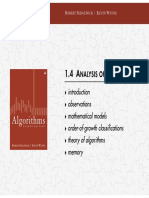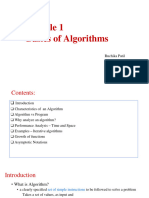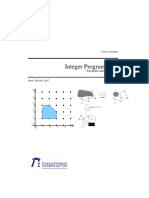0% found this document useful (0 votes)
69 views13 pagesAnalysis of Algorithm
This document discusses algorithms and their analysis. It covers algorithms used in physical design to optimize chip area, wire length, and vias. It also covers analyzing algorithm complexity through time complexity, space complexity, worst-case analysis, and average-case analysis. Asymptotic analysis is used to evaluate performance as input size increases. Big O notation, Omega notation, and Theta notation are introduced to describe the upper and lower bounds of an algorithm's running time. Examples are provided to demonstrate calculating time complexity.
Uploaded by
venkateshCopyright
© © All Rights Reserved
We take content rights seriously. If you suspect this is your content, claim it here.
Available Formats
Download as PDF, TXT or read online on Scribd
0% found this document useful (0 votes)
69 views13 pagesAnalysis of Algorithm
This document discusses algorithms and their analysis. It covers algorithms used in physical design to optimize chip area, wire length, and vias. It also covers analyzing algorithm complexity through time complexity, space complexity, worst-case analysis, and average-case analysis. Asymptotic analysis is used to evaluate performance as input size increases. Big O notation, Omega notation, and Theta notation are introduced to describe the upper and lower bounds of an algorithm's running time. Examples are provided to demonstrate calculating time complexity.
Uploaded by
venkateshCopyright
© © All Rights Reserved
We take content rights seriously. If you suspect this is your content, claim it here.
Available Formats
Download as PDF, TXT or read online on Scribd
/ 13























































































